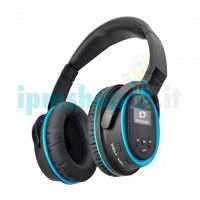In the world of technology and applied neuroscience, Forbrain and Soundsory represent two innovative tools designed to improve cognitive and sensory abilities. These devices leverage well-established scientific principles to offer benefits in learning, memory, and motor skills. Let’s take a closer look at the principles behind these technologies.
Helping the Brain Develop New Connections
One of the most significant scientific developments of the early 21st century has been the discovery of the extent to which neurons and neural connections can grow throughout human life. With 87 billion neurons and the possibility for each to establish up to 30,000 connections, the potential for brain development is limitless.
A few decades ago, scientists believed that the brain was relatively "immutable." It was thought that, after childhood, no new neurons developed and certain neural pathways became fixed. It was also believed that various brain areas were exclusively dedicated to their specialties and never deviated from them. Now, however, we know that the brain is much more complex. In some areas of the brain, new neurons grow throughout life. More importantly, new neural pathways can be formed, and when diseases or damage occur in one part of the brain, cortical maps can be redrawn to compensate for lost function. This ability of the brain to change is known as neuroplasticity (also called brain plasticity). It refers to the brain's ability to reorganize itself by forming new neural connections throughout our lives.
While it is now accepted that the brain is not immutable and can establish new connections, it is still unclear how we can support and facilitate this change. During childhood, while the brain is very immature, this plasticity is at its peak. Children can integrate a vast amount of behaviors and information and develop neural networks to compensate for damage or disease. In fact, the way our brain integrates and processes sensory information from birth should help us understand how we might encourage brain plasticity throughout life.
We estimate that three components are essential in the process of strengthening neural connections, just like a child learning to speak their native language:
Interest
Certainly, our motivation is fundamental, but here we are talking about "brain interest" much more than personal motivation. We need to capture the brain's attention to activate its interest. The more mature the brain, the harder it is to capture its attention. In Soundsory, music is processed with a dynamic filter designed to capture the brain's attention, much like a child naturally would with new sounds and melodies, to integrate their native language. The same happens with Forbrain, when you hear your voice processed with the dynamic filter through bone conduction.
Intensity
In the process of strengthening neural connections, the brain needs intense sensory training. Forbrain and Soundsory are perfectly suited for this task since 70% of brain stimulation comes from it. The combination of bone conduction exercises and body movement makes Forbrain and Soundsory sessions an intense program that educates the brain to better integrate multisensory information.
Repetition
We didn’t suddenly wake up one day with the ability to speak our native language or ride a bicycle. The brain needs time and repetition to explore new routes and pathways, like babbling before speaking. Building our brain requires time and repetition. The good news is that the brain establishes new connections; over time, it can turn those pathways into highways. For this reason, the Soundsory program is designed to be repeated for 40 days with a mix of music sessions and body movement exercises, and for the Forbrain method, cycles of 6 to 10 weeks are recommended.
Forbrain: Auditory Stimulation and Modified Auditory Feedback
Specifically, let’s see what makes Forbrain unique and how it can be helpful in various use cases:
- Dynamic Sound Filtering | Forbrain uses a dynamic sound filtering system that accentuates the frequencies of the human voice most useful for language processing. This process primarily involves the middle and high frequencies, crucial for speech clarity. The dynamic filter continuously modifies the perceived sound based on the user's voice, improving awareness of one's own speech.
- Bone Conduction | The device uses bone conduction to transmit sounds through the bones of the skull directly to the inner ear. This mode bypasses the eardrum and the ossicles, allowing for a more immediate and clear perception of sound. Bone conduction is a well-established technique also used in hearing aids and underwater communication devices.
- Delayed Auditory Feedback (DAF) | Delayed auditory feedback is a mechanism in which one’s voice is returned with a slight delay. This method has been studied for years and shown to be effective in improving speech fluency and reducing speech disorders, such as stuttering. Forbrain uses a variant of this concept, providing immediate and modified feedback that can improve pronunciation and language comprehension.
Soundsory: Sensory Integration and Neuromotor Stimulation
Specifically, let’s see what makes Soundsory unique and how it can be helpful in various use cases:
- Sound Therapy | Soundsory combines a series of specially selected and modified musical tracks to stimulate the brain. The music used has a particular emphasis on specific frequencies and rhythmic variations that promote neuronal activation and synchronization. Sound therapy is known for its beneficial effects on neuroplasticity, the brain's ability to reorganize itself by forming new synaptic connections.
- Rhythmic Movement | A key component of the Soundsory program is the integration of rhythmic movement. The motor exercises are designed to synchronize with auditory stimuli, promoting better motor coordination and sensory integration. This approach is based on research showing how rhythmic movement can enhance brain function and motor skills.
- Neuroplasticity | Both Forbrain and Soundsory are based on the concept of neuroplasticity. This scientific principle refers to the brain's ability to change and adapt in response to new experiences and stimuli. Regular use of these devices can lead to significant improvements in cognitive and motor functions through continuous stimulation and strengthening of neural connections.








